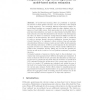Free Online Productivity Tools
i2Speak
i2Symbol
i2OCR
iTex2Img
iWeb2Print
iWeb2Shot
i2Type
iPdf2Split
iPdf2Merge
i2Bopomofo
i2Arabic
i2Style
i2Image
i2PDF
iLatex2Rtf
Sci2ools
164
click to vote
SCVMA
2004
Springer
2004
Springer
Comparison of Edge-Driven Algorithms for Model-Based Motion Estimation
3D-model-based tracking offers one possibility to explicate the manner in which spatial coherence can be exploited for the analysis of image sequences. Two seemingly different approaches towards 3Dmodel-based tracking are compared using the same digitized video sequences of road traffic scenes. Both approaches rely on the evaluation of greyvalue discontinuities, one based on a hypothesized probability distribution function for step-discontinuities in the vicinity of model-segments, the other one based on extraction of Edge Elements (EEs) and their association to model-segments. The former approach could be considered to reflect a stronger spatial coherence assumption because the figureof-merit function to be optimized collects evidence from all greyvalue discontinuities within a tolerance region around visible model segments. The individual association of EEs to model-segments by the alternative approach is based on a distance function which combines differences in position and or...
Computer Graphics | Greyvalue Discontinuities | SCVMA 2004 | Spatial Coherence | Stronger Spatial Coherence |
Related Content
| Added | 02 Jul 2010 |
| Updated | 02 Jul 2010 |
| Type | Conference |
| Year | 2004 |
| Where | SCVMA |
| Authors | Hendrik Dahlkamp, Artur Ottlik, Hans-Hellmut Nagel |
Comments (0)

